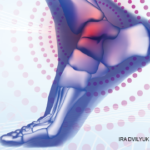In addition to coronary artery disease, his past medical history includes coronary artery bypass grafting, ischemic cardiomyopathy with placement of a pacemaker and ICD, resection of a bladder cancer and a small right common iliac artery aneurysm.
The patient had normal pulses bilaterally in all extremities. His first to fourth digits on his right foot had a bluish discoloration, as did his forefoot. His midfoot and fifth digit were red. The rest of his foot appeared normal.
Secondary Raynaud’s was unlikely due to a lack of any additional signs or symptoms suggestive of a particular connective tissue disease. The patient shared photos from his cell phone of his necrotic fingers prior to amputation. An atheroembolic phenomenon causing simultaneous ischemia of three digits all at the same arterial level seemed unlikely, and there was no history of trauma to the arm or hand that would lead one to suspect ulnar artery aneurysm and thrombosis. Cryoglobulinemia was suspected.
Further chart review revealed an abnormal serum protein electrophoresis in 2011 (revealing an IgM monoclonal gammopathy) with no additional follow-up on this test. Cryoglobulins were ordered and were positive. Unfortunately, the patient had been discharged home by the time this test result was known, because he had again experienced spontaneous improvement of his symptoms.
He did return to the emergency department a few weeks later, again complaining of discoloration and pain in the right foot. A serum protein electrophoresis was obtained at this time and again revealed a monoclonal IgM lambda protein. The patient was referred to hematology for a bone marrow biopsy, which revealed 20–30% involvement by a CD20+ B cell lymphoma (negative CD5 and CD10) with a smaller population of CD138 plasma cells.
The patient was diagnosed with lymphoplasmacytic lymphoma (Waldenström macroglobulinemia) complicated by type I cryoglobulinemia. He is being treated with plasmapheresis, rituximab and cyclophosphamide.
Discussion
Waldenström macroglobulinemia is a hematologic malignancy characterized by a lymphoplasmacytic bone marrow infiltration and the presence of immunoglobulin M (IgM) monoclonal protein.1 Usually, patients are elderly and asymptomatic at diagnosis. Constitutional and neuropathy-related symptoms may be present, as well as IgM-induced hyperviscosity-associated features. It is incurable.
Treatment is reserved for patients with severe constitutional symptoms, severe cytopenias, hyperviscosity-related symptoms, symptomatic lymphadenopathy, concomitant AL amyloidosis, IgM-related neuropathy and symptomatic cryoglobulinemia.
 Caitlin Kesari, MD, is a rheumatology fellow at the University of Cincinnati Medical Center. She is a graduate of Northeast Ohio Medical University (Rootstown, Ohio) and Mount Carmel West Internal Medicine Residency (Columbus, Ohio).
Caitlin Kesari, MD, is a rheumatology fellow at the University of Cincinnati Medical Center. She is a graduate of Northeast Ohio Medical University (Rootstown, Ohio) and Mount Carmel West Internal Medicine Residency (Columbus, Ohio).
 Avis E. Ware, MD, is a professor of medicine and the program director for the Rheumatology Fellowship Training Program at the University of Cincinnati Medical Center.
Avis E. Ware, MD, is a professor of medicine and the program director for the Rheumatology Fellowship Training Program at the University of Cincinnati Medical Center.
Reference
- Kapoor P, Paludo, J, Vallumsetla N, et al. Waldenström macroglobulinemia: What a hematologist needs to know. Blood Rev. 2015 Sep;29(5):301–319.

